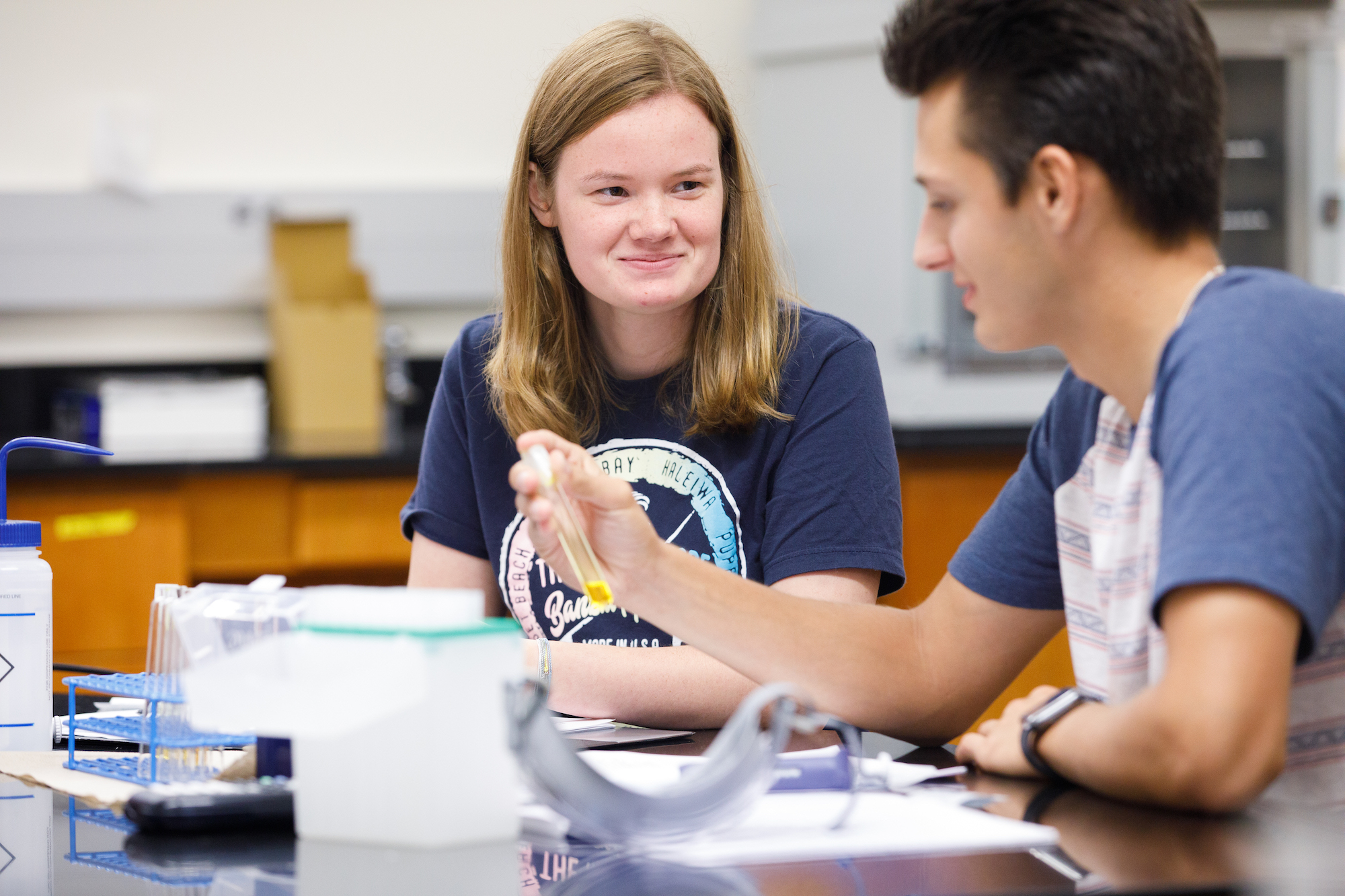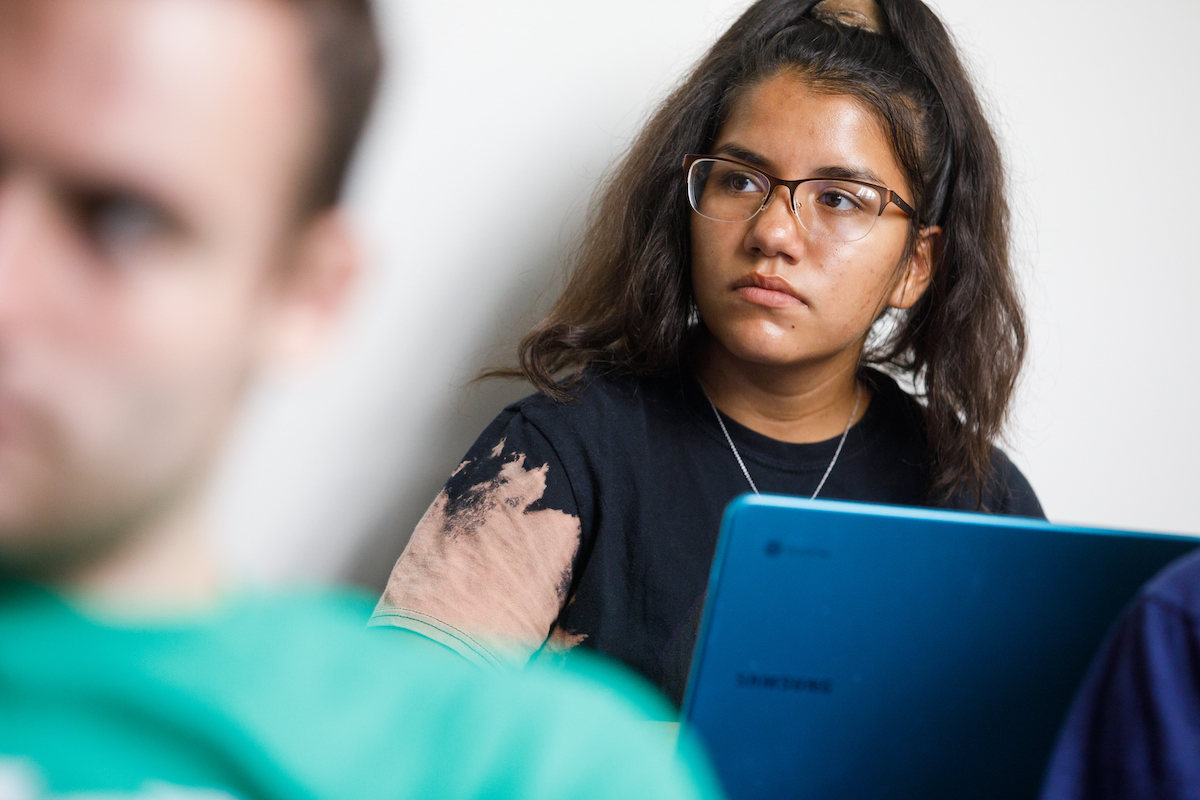Albion College, Nottawaseppi Huron Band of the Potawatomi learn from each other in unique partnership
Related Posts
Connect With Us
Tall slender strands of wild rice rising out of the Nottawa Creek are helping to nourish a partnership between Albion College and the Nottawaseppi Huron Band of the Potawatomi tribe in Michigan’s Calhoun County.
February 26, 2024
“The rice is a part of our connection to the land. It’s about our values and culture,” said elder, veteran, and Nottawaseppi Tribal Historic Preservation Officer Doug Taylor.
Known to indigenous Anishinaabe people as manoomin, or “the good berry,” this aquatic plant has nourished the Potawatomi and other Indigenous peoples of the Great Lakes, both physically and spiritually, for generations.
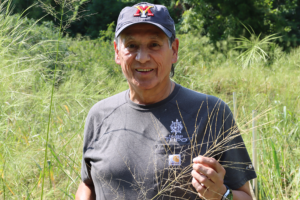
Doug Taylor, Nottawaseppi Tribal Historic Preservation Officer
Understanding how to help manoomin’s thrive is very important to the Anishinaabe culture, which in Michigan includes the Potawatomi, the Odawa and the Ojibwe (or Chippewa). Once widespread, manoomin in Michigan was nearly eradicated by settler activities. Today, all twelve of Michigan’s federally-recognized tribes are working with state, federal, and regional partners to restore and preserve the sacred plant.
“We have very vigorous manoomin beds here, but we are still learning a lot about the science,” Taylor said.
Dr. Allison Harnish, associate professor of anthropology, contacted the tribe in 2020 to discuss the potential of initiating a collaborative research project. When Taylor and John Rodwan, environmental director for the tribe, communicated their interest in working with Albion faculty and students to support ongoing manoomin restoration efforts, Harnish introduced them to Dr. Abigail Cahill. Cahill is an associate professor and marine biologist at Albion who studies small animals called macroinvertebrates. The aquatic worms, leeches, snails, crayfish, and insect larvae are useful for assessing water quality and the health of wetland ecosystems.
At the time, Cahill was supervising the undergraduate honors thesis research of Jess Garcia-Lopez ’22, who found macroinvertebrate populations were richer and more biodiverse in areas of the Kalamazoo River where manoomin grows. This result seemed to corroborate prior knowledge on the part of Indigenous communities about the importance of wild rice for overall ecosystem health. In the three years since, Cahill has been attempting with students to replicate this finding, but with an added twist.
One conventional method for studying macroinvertebrates is to replace two sides of a small rectangular plastic container with a fine metal screen. Researchers fill a series of containers with leaf litter (food for the macroinvertebrates) and anchor them in the river for two weeks. The devices are pulled from the river and the quantity, ratios, and diversity of macroinvertebrate species is logged.
“When we shared Jess’s findings with Doug and John, they challenged us to build a macroinvertebrate collector out of locallyavailable, biodegradable materials, rather than plastic–which contains harmful chemicals and contributes to global pollution problems,” Cahill said.
Cahill, Harnish, and several students including Garcia-Lopez, Jason Bigpond ’22, and Madeline Prall ’22 experimented with making screens out of pine needles and deer hide. They soaked birchbark to make it malleable, then folded it into rectangular boxes. “We were adapting technologies traditionally used in the manufacturing of birchbark canoes for a new purpose,” said Harnish. “But, we were worried about the thin strips of bark retaining their shape when submerged in water and tossed by currents, and we weren’t confident in our ability to weave the screens on a large scale. We’d also been thinking we needed to reproduce the rectangular shape of the plastic collector, until John showed us a picture of a cylindrical birchbark storage jar.”
That’s when the students, Cahill, and Harnish realized they could be wrapping the birchbark, instead of folding it. But, the cylindrical container would still need a rigid interior frame to support the flexible birchbark exterior.
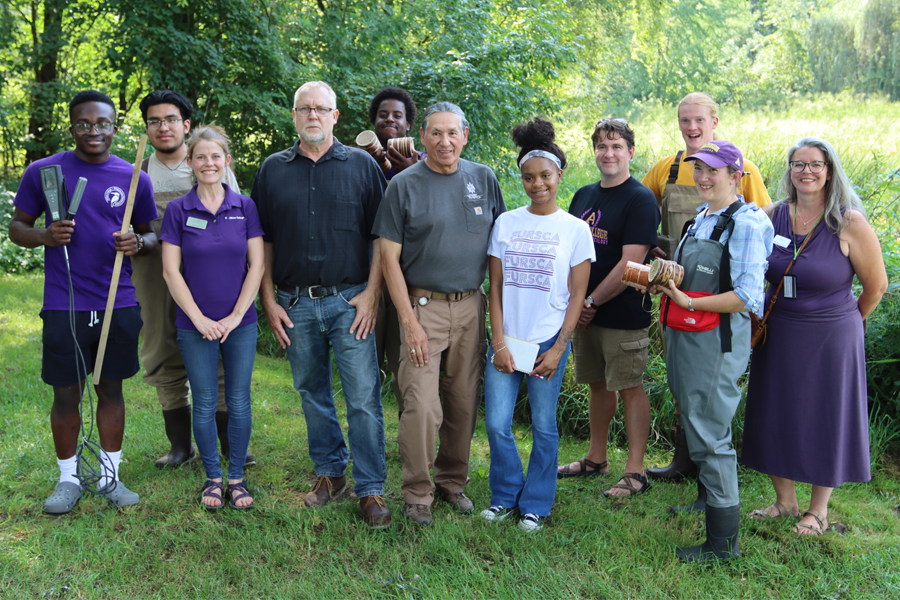
Daniel Jeremiah ’25, Adrian Sanchez ’26, Prof. Allison Harnish, John Rodwan, Miles Newman ’25, Doug Taylor, Ty’Nayia George ’25, Prof. Brad Chase, Kelvin Crone-Willis ’25, Prof. Abigail Cahill, Monica Day
The response to that request came from biology major Daniel Jeremiah ’25, a junior from Nigeria, who used 3-D printing technology to design and create the prototype of the macroinvertebrate collector that is currently being used by Cahill and her students. In place of plastic filament, Jeremiah’s design calls for a mix of wood pulp and corn starch. The 3-D printed biodegradable frame is then wrapped in birchbark and tied with artificial sinew.
“We looked at a lot of bug catcher designs,” Jeremiah said. “We needed to incorporate natural ingredients that were strong and kept it cost effective. We wanted to use birchbark, because that is culturally significant to Potawatomi people.”
With the design established, Jeremiah worked with then-director of the Whitehouse Nature Center Jason Raddatz ’91 and other Nature Center assistants to print a dozen frames in spring 2022. Harnish’s ANTH 325: Methods in Anthropology students assembled the two halves of the 3D-printed frames, stuffed them with leaf litter provided by the College’s Grounds crew, wrapped them in birchbark and tied them with artificial sinew. Cahill and her students deployed the collectors and analyzed their contents.
Cahill said the manoomin project has Albion College students across three departments (biology, environmental studies, and anthropology) assembling, deploying, and analyzing the collectors and their contents.
“We are comparing the abundance and diversity of macroinvertebrates in sites with and without manoomin,” said Kelvin CroneWillis ’25, an environmental studies major from St. Louis, Missouri.
While the premise of the project may seem simple enough, Cahill said the variables change with each season, making the project even more challenging.
“It’s how the critters are responding to the seasons over time,” Cahill said. “It’s complicated to unravel, but it is cool to have this opportunity.”
After multiple trial runs and multiple iterations of Jeremiah’s design, it was determined the birchbark collectors function just as well as the conventional plastic ones, though they are smaller in size. The seventh iteration of the collection device is being printed in the College’s new Innovation Lab with help from Sarah Noah, Albion College’s Director of Instructional Technology and Web Development.
“Once upon a time, we were thinking we needed to seal the collectors with spruce sap, and Sarah 3-D printed a mold that would allow us to push the sap through a hot glue gun,” Harnish said. The collaboration between students and faculty, across multiple academic departments, with Instructional Technology and the Whitehouse Nature Center is reflective of the intimate, integrative, and experiential learning that happens at Albion College. That this work is being carried out in partnership with the Nottawaseppi follows an ethical and inclusive shift happening in the natural and social sciences, which have not always approached Indigenous communities with a collaborative spirit.
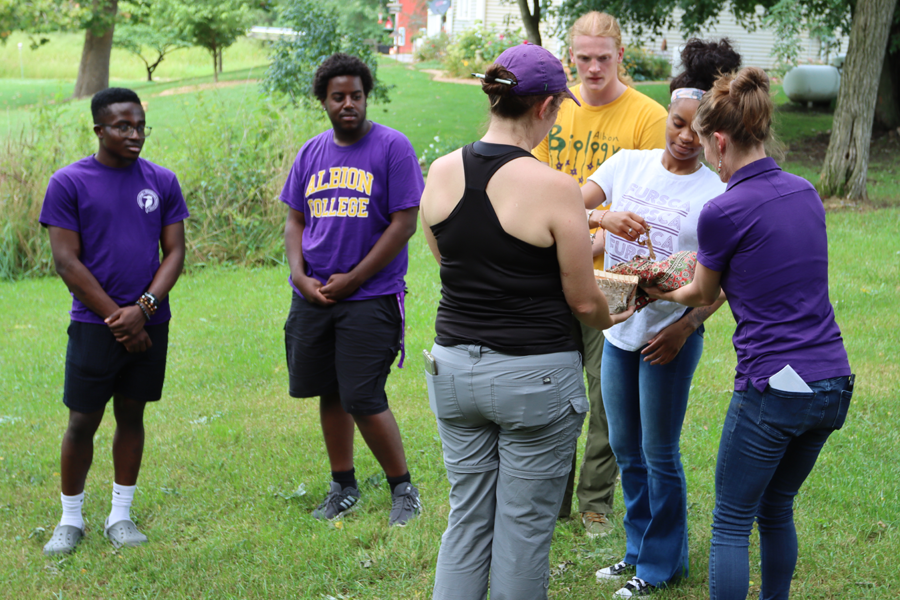
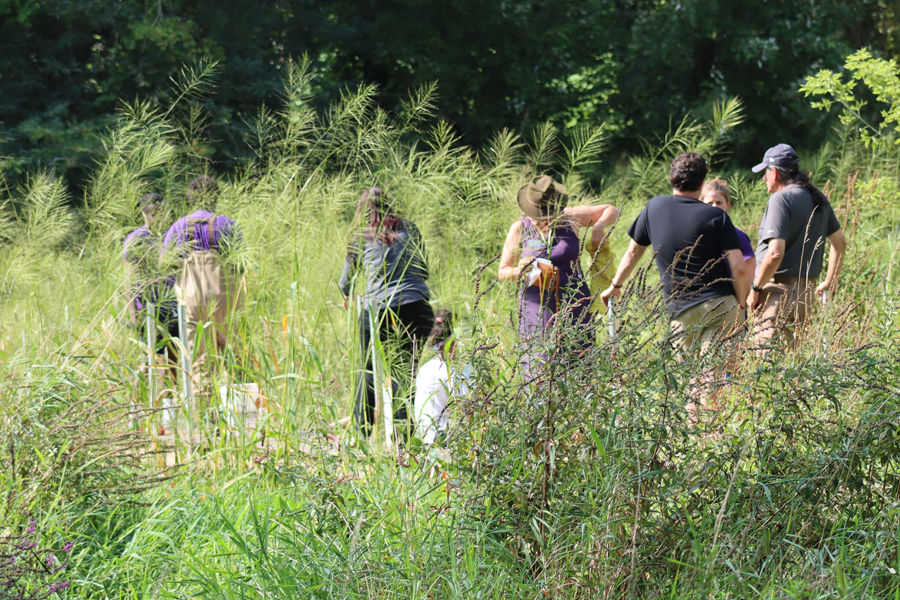
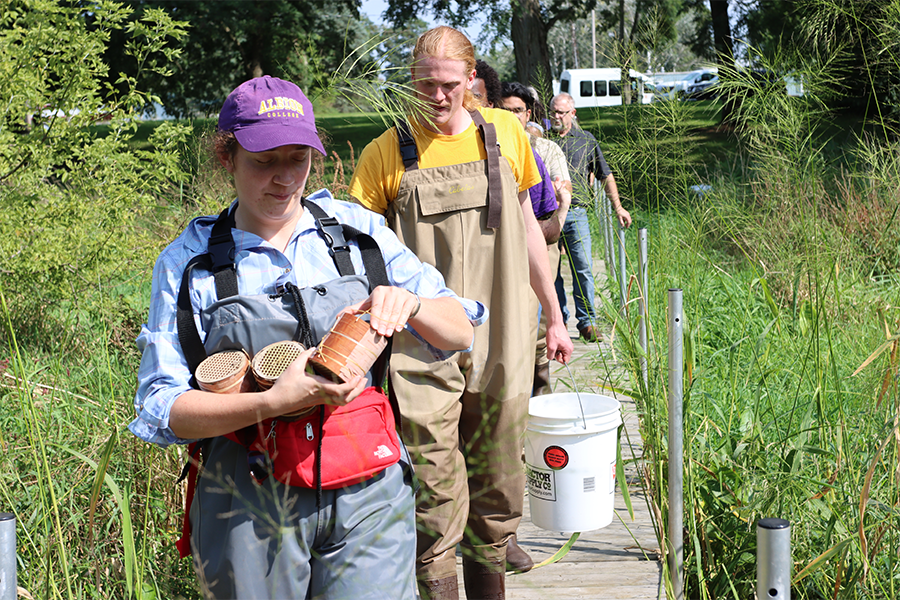
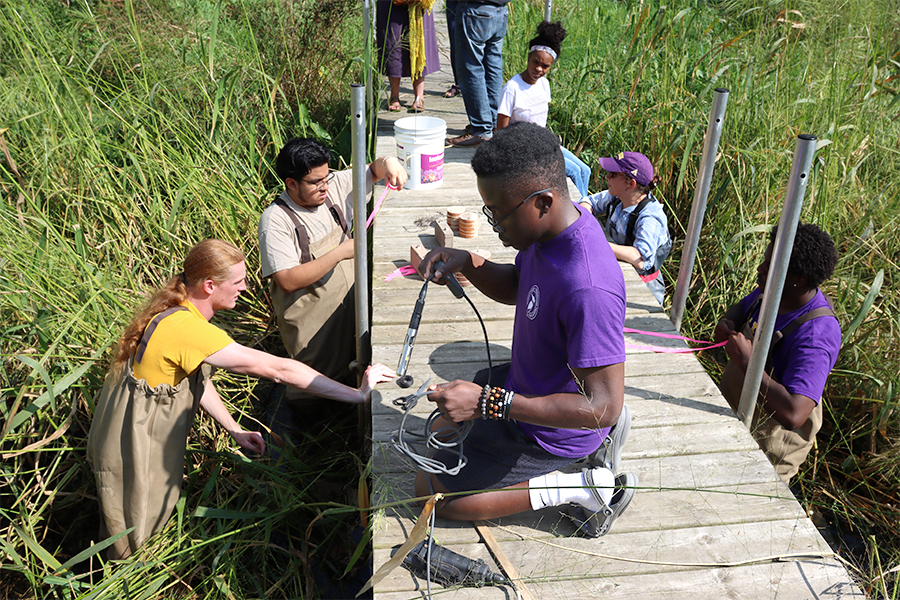
“It’s a marriage of world views, of Western and Indigenous science,” said Harnish. “We are working directly with them and they are leading what we do. We are not telling them what we are going to do on their land.”
The mutually-beneficial partnership highlights the knowledge and worldview of the tribe while providing experiential learning and community outreach opportunities for students.
“We are neighbors,” said Rodwan. “We knew about Albion’s connection to the land. Albion has a rich history of tribal participation. Some places just want to put a plaque up on their football stadium (about the land). Albion is more collaborative and we wanted a partnership where we could learn from each other.”
Beyond the scientific data, Cahill said the benefits of the partnership for Albion has many layers. “We are producing knowledge for all of us to share,” Cahill said. “None of our students had met the tribe before but the tribe has connected with them now. This is an opportunity for students to do very tangible work and hands-on learning that contributes to new knowledge that helps the tribe.”
While the “birch bark box” is collecting information to help the tribe, Taylor said it is the outside-the-box thinking the partnership has generated that is significant beyond the boundaries of the reservation.
The team has plans to release the blueprints for the device so other tribes and tribal partners who are studying aquatic ecosystem health can use it and make their own modifications.
“This project validates our life ways and values through science,” Taylor said. “It is providing education and experience to the students and brings to light that which has never been published. It makes the students the keepers of the subject matter. It helps us build a sustainability model that will help our people in the future.”
In September, the Albion team, which until then had been exclusively studying manoomin and macroinvertebrates in the Kalamazoo River, were invited to deploy the now tried and tested biodegradable collectors in Nottawa Creek, near the Nottawaseppi’s Pine Creek Reservation. The deployment was preceded by a ceremonial offering of tobacco, and the team was honored when Taylor and Rodwan gave the device a Potawatomi name: wigwas-mkek (wigwas-mkok in plural), which translates to “birch bark container.”
After some discussion, it was decided that Albion College students Jeremiah, CroneWillis, Adrian Sanchez ’26, Miles Newman ’25, and Ty’Nayia George ’25 would deploy seven wigwas-mkok in recognition of the Seven Grandfather Teachings and the Seven Generations philosophy, which guide Anishinaabe people to live “in a good way.” These teachings, which were communicated to those gathered by Taylor, urge humans to be sincere in their actions, words, and character by practicing love, respect, bravery, truth, honesty, humility, and wisdom. They maintain tradition and encourage sustainable futures by calling for accountability to three generations past and three generations yet to come.
Six of the seven wigwas-mkok will be retrieved after two weeks, so analysis can begin. One will stay in the Nottawa Creek through the winter and into next year as a symbol of the ongoing relationship between the tribe and the College.
In a recent visit to Albion College, Taylor and Rodwan recommended the manoomin and macroinvertebrate research team plant yellow birch trees to offset the greenhouse gasses that are emitted when 3-D printers use electricity. Director of the Whitehouse Nature Center, Monica Day, has already identified an ideal location and plans for the birch to replace an invasive species that’s altering the soil chemistry and displacing native plants on which local fauna depend.
“This is about history, the present and the future,” Taylor said. “It is not just about our tribe, but everyone on Earth and preserving the environment for everyone.”
This story originally appeared in the Winter 2024 edition of the Io Triumphe!
